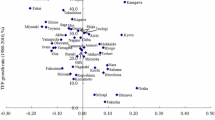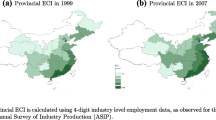Abstract
This paper quantifies the effects of some proximate causes for the regional productivity disparities of China in 1997 and their growth in the five years thereafter. A novel shift-share approach based on input–output data is used to divide the regional differences, so that explicit attention is paid to the regional consequences of China’s specific role in global production networks (with a focus on sectoral value added coefficients). In the process, a new method is proposed to deflate the data in constant prices. The results show that regions with high labor productivity levels in 1997 generally experienced increases of the employment shares in sectors with high productivity levels.


Similar content being viewed by others
Notes
GDP per capita is in thousands of RMB, labor productivity in thousands of RMB per worker. Data were taken from National Bureau of Statistics (2007).
See also Yang and Lahr (2008), who use an interregional input–output structural decomposition approach to analyze labor productivity growth between 1987 and 1997 for seven regions in China, distinguishing seven sectors.
Wang and Szirmai (2008) also apply shift-share techniques to account for aggregate labor productivity growth in Chinese regions. Whereas their study explicitly focuses on the consequences of changing shares of state-owned and privately owned companies in employment (next to changes in sectoral employment shares and sectoral productivity growth for ownership type-sector combinations), the present study has a specific focuses on the labor productivity growth effects of changes in the parts of value chains captured by industries in each of the regions.
See Jiang (2011) for the details.
For example, the new figure for GDP in 2004 was 16.8 % larger than the previous estimate.
The input–output tables are available for 27 regions, tables for Qinghai, Xinjiang, Tibet, and Hainan are not available. This implies that the national deflators for sectors may include small errors because they are based on the national table (i.e., implicitly giving the weighted average of all 31 regions, instead of just the 27 regions covered in our application). Given the small contribution of these four regions, the errors are expected to be very small.
The major reason for this choice (and not adapt the deflated regional values added) was the fact that the sectoral prices indices may include small errors, as explained in the previous footnote.
It should be borne in mind, however, that the growth percentages are not entirely comparable because of the discrepancies between the national average and the average of the regional results as discussed above.
See Yang et al. (2009) for input–output analyses of nationwide differences between processing trade activities, other production activities for exporting purposes and production activities for domestic customers.
Such shifts would not show up in SESratios if workers would move from a state-owned company to a privately owned company in the same sector, but since most of the jobs concerned do not require specific skills, intersectoral labor mobility is likely to have been large.
Wang and Fan (2004) estimated that the labor force flows had accumulated to 28 million persons at the end of 2000. 90 % of these people left non-coastal regions (56 % from the central regions and 34 % from western regions), while 82 % of them flowed into the Eastern regions (in particular Guangdong, Fujian, Zhejiang, Shanghai, and Beijing). It should be noted, however, that the official labor force data as based on surveys have been reported to underestimate interprovincial migration largely (see, for example, Rawski 2001; Holz 2003; Young 2003).
References
Altenburg T, Schmitz H, Stamm A (2008) Breakthrough? China’s and India’s transition from production to innovation. World Dev 36:325–344
Bosworth B, Collins SM (2008) Accounting for growth: comparing China and India. J Econ Perspect 22:45–66
Caves DW, Christensen LR, Diewert WE (1982) Multilateral comparisons of output, input, and productivity using superlative index numbers. Econ J 92:73–86
Chen B, Feng Y (2000) Determinants of economic growth in China: private enterprise, education and openness. China Econ Rev 11:1–15
Davies SW, Lyons BR (1991) Characterising relative performance: the productivity advantage of foreign owned firms in the UK. Oxf Econ Papers 43:584–595
Dayal-Gulati A, Husain A (2000) Centripetal forces in China’s economic take-off. International Monetary Fund, Washington, DC, IMF working paper 00/86
Dekle R, Vandenbroucke G (2010) Whither Chinese growth? A sectoral growth accounting approach. Rev Dev Econ 14:487–498
Démurger S, Sachs JD, Woo WT, Bao S, Chang G, Mellinger A (2002) Geography, economic policy and regional development in China. Asian Econ Pap 1:146–197
Démurger S, Gurgand M, Li S, Yue X (2009) Migrants as second-class workers in urban China? A decomposition analysis. J Comp Econ 37:610–628
Dietzenbacher E, Los B (1998) Structural decomposition techniques: sense and sensitivity. Econ Syst Res 10:307–323
Dietzenbacher E, Hoen AR, Los B (2000) Labour productivity in Western Europe (1975–1985): an intercountry, interindustry analysis. J Reg Sci 40:425–452
Dietzenbacher E, Lahr ML, Los B (2004) The decline in labor compensation’s share of GDP: a structural decomposition analysis for the US, 1982–1997. In: Dietzenbacher E, Lahr ML (eds) Wassily Leontief and input–output economics. Cambridge University Press, Cambridge, pp 188–212
Dinc M, Haynes K (2005) Productivity, international trade and reference area interactions in shift-share analysis: some operational notes. Growth Change 36:374–394
Dunn ES (1960) A statistical and analytical technique for regional analysis. Pap Proc Reg Sci Assoc 6:97–112
Eltetö O, Köves P (1964) One index computation problem of international comparisons. Stat Szle 7:507–518
Fagerberg JE (2000) Technological progress, structural change and productivity growth: a comparative study. Struct Change Econ Dyn 11:393–411
Fleisher BM, Chen J (1997) The coast-noncoast income gap, productivity and regional economic policy in China. J Comp Econ 25:220–236
Fothergill S, Gudgin G (1982) Unequal growth: urban and regional employment change in the UK, Heinemann Educational Books, London
Fox JK (2006) A method for transitive and additive multilateral comparisons: a transitive Bennet indicator. J Econ 87:73–87
Fujita M, Hu D (2001) Regional disparity in China 1985–1994: the effects of globalization and economic liberalization. Ann Reg Sci 35:3–37
Geary RC (1958) A note on the comparison of exchange rates and purchasing power between countries. J R Stat Soc Ser A 21:97–99
Holz CA (2003) Fast, clear and accurate: how reliable are Chinese output and economic growth statistics. China Q 173:122–163
Jiang X (2011) Statistical and economic applications of Chinese regional input–output tables. Dissertation, University of Groningen, The Netherlands
Kanbur R, Zhang X (2005) Fifty years of regional inequality in China: a journey through central planning, reform, and openness. Rev Dev Econ 9:87–106
Khamis SH (1972) A new system of index numbers for national and international purposes. J R Stat Soc Ser A 135:96–121
Lee J (1994) Regional differences in the impact of the open door policy on income growth in China. J Econ Dev 19:215–234
Lin JY, Liu P (2005) Development strategies and regional income disparities in China. China Center for Economic Research, Peking University, Beijing, CCER working paper no. E2005005
Lin Y, Cai F (2003) Chinese economy: reform and development. China Financial and Economic Publishing House, Beijing (in Chinese)
Ma AC, van Assche A, Hong C (2009) Global production networks and China’s processing trade. J Asian Econ 20:640–654
Miller RE, Blair PD (2009) Input–output analysis: foundations and extensions, 2nd edn. Cambridge University Press, Cambridge
National Bureau of Statistics (NBS) (1998) China statistical yearbook 1998. China Statistics Press, Beijing
National Bureau of Statistics (NBS) (2003) China statistical yearbook 2003. China Statistics Press, Beijing
National Bureau of Statistics (NBS) (2004) Data of gross domestic product of China, 1996–2002. China Statistics Press, Beijing
National Bureau of Statistics (NBS) (2005) The compilation methods of Chinese input–output tables. China Statistics Press, Beijing (in Chinese)
National Bureau of Statistics (NBS) (2007) China statistical yearbook 2007. China Statistics Press, Beijing
National Bureau of Statistics and Ministry of Labour and Social Security (NBS/MoLSS) (1998) China labour statistical yearbook 1998. China Statistics Press, Beijing
National Bureau of Statistics and Ministry of Labour and Social Security (NBS/MoLSS) (2003) China Labour statistical yearbook 2003. China Statistics Press, Beijing
Naughton B (2002) Provincial economic growth in China: causes and consequences of regional differentiation. In: Renard M-F (ed) China and its regions: economic growth and reform in Chinese provinces. Edward Elgar, Cheltenham
Paci R, Pigliaru F (1997) Structural change and convergence: an Italian regional perspective. Struct Change Econ Dyn 8:297–318
Rawski TG (2001) What is happening to China’s GDP statistics. China Econ Rev 12:347–354
Rice P, Venables AJ, Patacchini E (2006) Spatial determinants of productivity: analysis for the regions of Great Britain. Reg Sci Urban Econ 36:727–752
Shiu A, Heshmati A (2006) Technical change and total factor productivity growth for Chinese provinces: a panel data analysis, Bonn, Institute for the Study of Labor (IZA), IZA discussion paper 2133
Slyvie D (2001) Infrastructure development and economic growth: an exploration for regional disparity in China. China Econ Rev 11:246–261
Stevens BH, Moore CL (1980) A critical review of the literature on shift-share as a forecasting technique. J Reg Sci 20:419–437
Stone R, Brown A (1962) A computable model of economic growth. Chapman and Hall, London
Syrquin M (1984) Resource allocation and productivity growth. In: Syrquin M, Taylor L, Westphal E (eds) Economic structure and performance: essays in honor of Hollis B. Chenery. Academic Press, Orlando, pp 75–101
Szulc B (1964) Indices for multiregional comparisons. Prd Stat 3:239–254
Tsui KY (2007) Forces shaping China’s interprovincial inequality. Rev Income Wealth 53:60–92
Wang L (2009) Aggregate and regional productivity growth in Chinese industry, 1978–2002. PhD thesis, Eindhoven University of Technology, The Netherlands
Wang X, Fan G (2004) Analysis on the regional disparity in China and the influential factors. Econ Res 1:33–44 (in Chinese)
Wang L, Szirmai A (2008) Productivity growth and structural change in Chinese manufacturing. Ind Corp Change 17:841–874
Yang L, Lahr M (2008) Labor productivity differences in China, 1987–1997: an interregional decomposition analysis. Rev Reg Stud 38:319–341
Yang C, Chen X, Dietzenbacher E, Pei J, Zhu K, Tang Z (2009) The bias in measuring vertical specialization. Paper presented at the 17th international input–output conference (Sao Paulo, Brazil, June 13–17)
Young A (2000) The razor’s edge: distortions and incremental reform in the People’s Republic of China. Q J Econ 115:1091–1135
Young A (2003) Gold into base metals: productivity growth in the People’s Republic of China during the reform period. J Polit Econ 111:1220–1261
Author information
Authors and Affiliations
Corresponding author
Appendix
Rights and permissions
About this article
Cite this article
Jiang, X., Dietzenbacher, E. & Los, B. A dissection of the growth of regional disparities in Chinese labor productivity between 1997 and 2002. Ann Reg Sci 52, 513–536 (2014). https://doi.org/10.1007/s00168-014-0597-1
Received:
Accepted:
Published:
Issue Date:
DOI: https://doi.org/10.1007/s00168-014-0597-1




